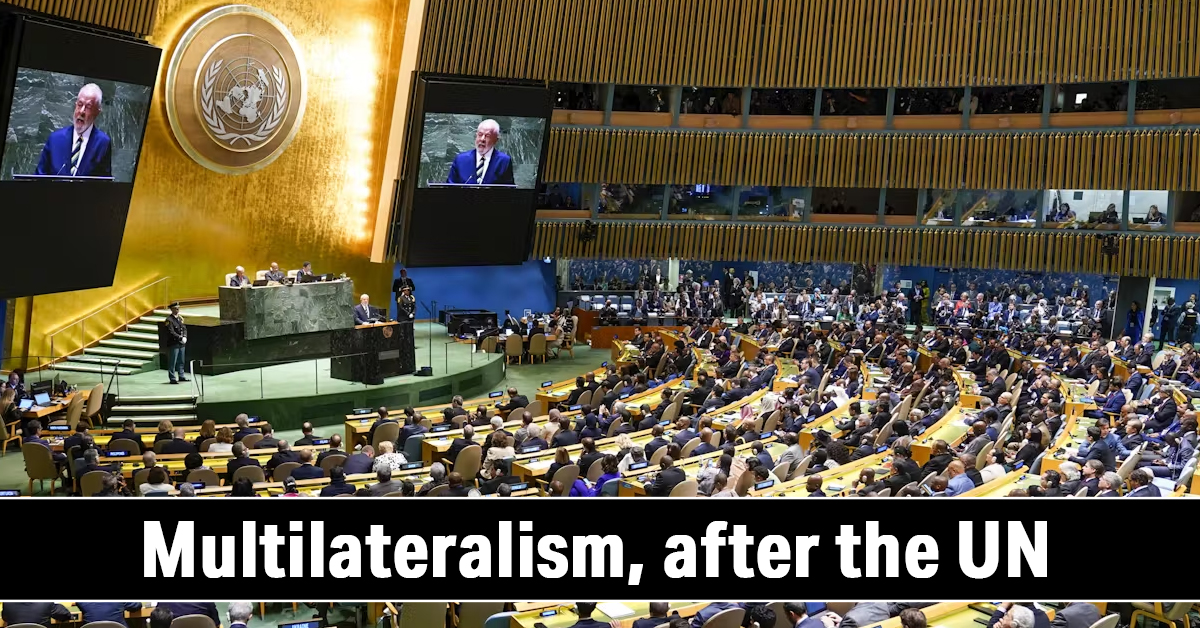Table of Contents
The world today stands at a crucial crossroads. As the United Nations (UN) completes 80 years of its existence, debates around its relevance, effectiveness, and legitimacy have grown louder. The UN, established in 1945 after World War II, was envisioned as a guardian of global peace and a platform for international cooperation.
However, in the 21st century, wars, humanitarian crises, and geopolitical rivalries have exposed the limits of the UN system. This has led many thinkers, including Indian strategist Ram Madhav, to argue that “The UN is dead. Long live multilateralism.”
The call today is not merely for UN reform but for a new form of multilateralism — one that reflects multipolar realities and ensures equitable participation of all nations.
What is Multilateralism?
Multilateralism refers to a system of global governance where multiple countries cooperate on common issues through international institutions and agreements.
Its core principles include:
-
Inclusivity: Equal participation of all nations.
-
Consensus-building: Collective decision-making rather than unilateral action.
-
Global solidarity: Joint solutions for global challenges such as climate change, pandemics, and peacekeeping.
In the post-World War II order, the UN became the primary symbol of multilateralism. Yet, as power dynamics shift, this structure appears outdated.
The Decline of the United Nations System
1. Structural Flaws
The UN operates on a contradictory foundation — equal voting rights for 193 members (“one nation, one vote”) combined with an undemocratic veto system in the UN Security Council (UNSC).
The five permanent members (P5) — the US, UK, France, Russia, and China — enjoy veto powers that can block any resolution, regardless of majority support.
This imbalance has led to paralysis in decision-making, especially in crises like Ukraine, Gaza, and Syria.
2. Political Disinterest
World leaders are losing faith in the UN. In recent sessions, attendance of heads of government has sharply declined.
Even major powers like Xi Jinping and Vladimir Putin have skipped UNGA meetings for years, signaling waning relevance.
3. Hypocrisy and Double Standards
Countries with poor human rights records often sit on human rights or women’s rights councils, undermining credibility.
Meanwhile, power politics determines which crises receive global attention — Palestine has seen multiple emergency sessions, while Rwanda, Sudan, or Yemen often remain ignored.
4. Historical Parallels
The current crisis mirrors the collapse of the League of Nations in the 1930s — a body that failed to prevent World War II due to its weak structure and lack of political will.
The UN, born in 1945 to replace it, now faces a similar fate unless global governance is reimagined.
The Rise of a Multipolar World
The 21st century marks the end of unipolarity. The dominance of the United States after the Cold War is gradually giving way to multipolarity, where power is distributed among several influential actors:
-
India: Emerging as a voice of the Global South and advocate of “reformed multilateralism.”
-
China: Expanding influence through the Belt and Road Initiative (BRI) and BRICS.
-
European Union: Acting as a regional power bloc promoting normative diplomacy.
-
Middle Powers: Nations like Japan, Brazil, and South Africa driving issue-based cooperation.
This new reality demands a reshaped multilateral order — flexible, inclusive, and regionally empowered.
Emerging Models of Post-UN Multilateralism
1. Regional Multilateralism
Regional organizations are increasingly filling the global vacuum:
-
ASEAN (Southeast Asia) – promotes peace and economic integration.
-
African Union (AU) – seeks political unity and development.
-
European Union (EU) – a successful supranational model of cooperation.
-
SCO (Shanghai Cooperation Organisation) – focuses on security and economic collaboration in Eurasia.
Such frameworks allow region-specific problem-solving, reducing dependency on Western-dominated institutions.
2. Issue-Based Multilateralism
Modern global challenges are transnational — climate change, pandemics, digital security — and demand coalitions of the willing, not universal consensus.
For example:
-
Paris Climate Agreement (2015)
-
QUAD (India, US, Japan, Australia) for Indo-Pacific security
-
G20, a flexible forum representing 80% of global GDP, has emerged as a more effective economic platform than the UN.
3. BRICS and the Global South
The BRICS bloc (Brazil, Russia, India, China, South Africa) has evolved into a symbol of non-Western multilateralism.
Its expansion and new institutions like the New Development Bank (NDB) indicate a shift from Western-centric global governance to Southern-led cooperation.
4. Digital and Climate Multilateralism
The rise of AI governance frameworks, climate finance alliances, and data-sharing agreements reflects the next frontier of multilateralism — one that is network-based and domain-specific, not necessarily state-centric.
India’s Role in the New Multilateral Order
India’s foreign policy today emphasizes “Vasudhaiva Kutumbakam” — the world as one family.
Through initiatives like:
-
International Solar Alliance (ISA)
-
Coalition for Disaster Resilient Infrastructure (CDRI)
-
Voice of Global South Summit (2023–24)
India promotes inclusive, sustainable, and equitable multilateralism beyond traditional power politics.
As a leading democracy and emerging power, India stands at the center of shaping a reformed or post-UN global order.
Challenges Ahead
| Challenge | Explanation |
|---|---|
| Fragmentation | Rise of competing blocs (NATO vs BRICS) could polarize cooperation. |
| Lack of Leadership | No Roosevelt–Churchill–like figures to envision a new framework. |
| Power Imbalance | Smaller nations fear marginalization in regional coalitions. |
| Institutional Trust Deficit | Global South skepticism toward Western-dominated norms. |
Conclusion
The world has entered an era where global governance must evolve beyond the rigid structures of 1945.
While the UN remains symbolically important, its institutional decay and political irrelevance demand a new vision of multilateralism — one rooted in equality, accountability, and regional empowerment.
The phrase “The UN is dead. Long live multilateralism” encapsulates the transformation from institutional dependence to dynamic cooperation.
As humanity faces shared challenges — from wars to climate change — only a reimagined multilateral system can ensure peace, prosperity, and justice in the 21st century.


 Securities Markets Code Bill 2025: Towar...
Securities Markets Code Bill 2025: Towar...
 Weakly Interacting Massive Particles (WI...
Weakly Interacting Massive Particles (WI...
 India–Oman Trade Deal: CEPA Signed to ...
India–Oman Trade Deal: CEPA Signed to ...

























